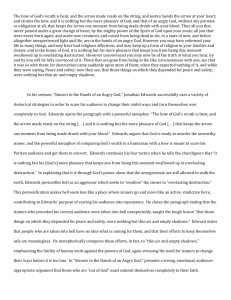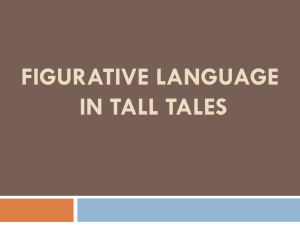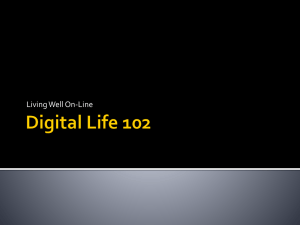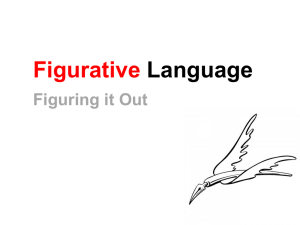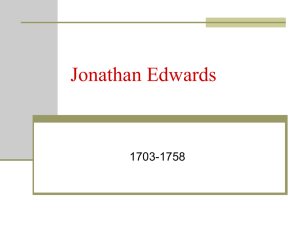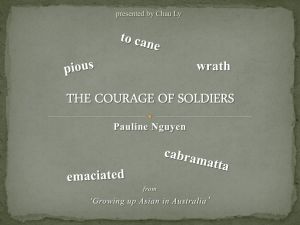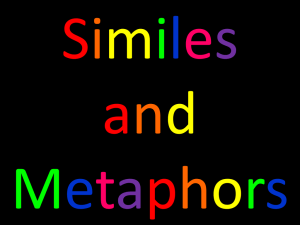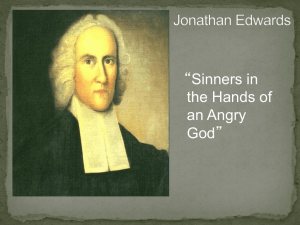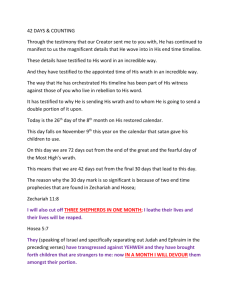Sinners in the Hands of an Angry God
advertisement
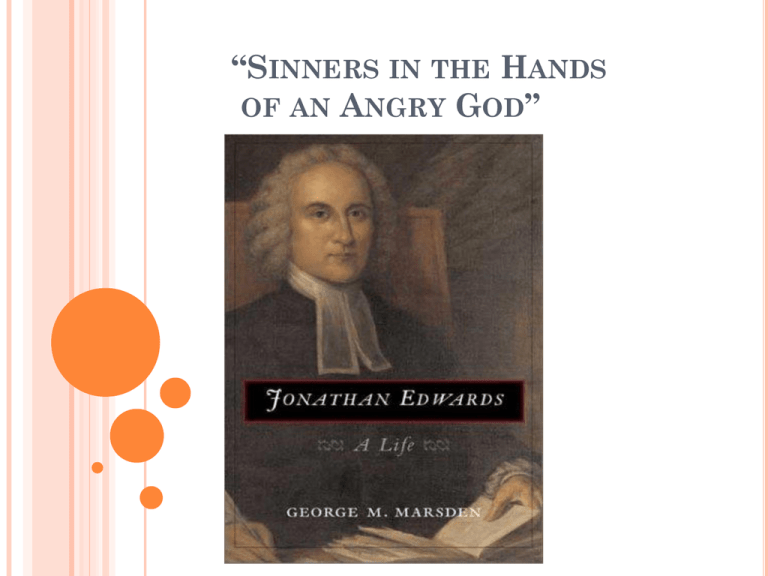
“SINNERS IN THE HANDS OF AN ANGRY GOD” JONATHAN EDWARDS Jonathan Edwards was the son of a minister, and had a religious bent early in life • As a young boy, he played "revival" in the woods with other children. With the use of a home-made wooden booth, a child would play the pastor. • He was born in 1703, and was diligently playing revival with his neighbors around 1711 or 1713. • He attended Yale University - Five years after he had completed his theological studies he accepted the pastorate of the Congregational Church of Northampton, Massachusetts. His predecessor was Samuel Stoddard, his grandfather. • In 1734 he began a series of sermons on "Justification by Faith Alone." HOW THINGS GOT SO BAD Great Migration - 1630-1642 = 20,000 Puritans Not all the other colonists were Puritans Towns created - Governed by strict Puritan Farms/plantations far from center of town People lived far from center of town and place of worship People couldn’t spend time at church; they had to take care of their land = survival IN ADDITION: In the 17th C - people like Sir Isaac Newton emerged Humans had the ability to discover secrets of the universe People could control their destiny Unlike early thoughts, one’s destiny was not solely in the hands of God Religion became more rational The Great Awakening Revivals in different towns “SINNERS IN THE HANDS OF ANGRY GOD” Delivered 1741 Subject matter - salvation from the wrath of God. God is an angry and wrathful being. Message - those who feel the power of God may come forward, confess their sins and profess their new-found faith and join the family of God, thus ensuring salvation “SINNERS …” Persuasive - tone, word choice, pace, rhetorical questions ‘the voice of passion” “the furnace is ready, the fire is hot, the flames are leaping,the pit is ready to receive you into its depths” Quick to rapid “abominable, abhors, sinful” “Do you understand “everlasting”?? LISTEN!!! http://www.thesermon1741.com/index.html WHAT IS IMAGERY? An image is a literal and concrete representation of a sensory experience or of an object that can be known by one or more of the senses. The image is a distinctive element of the language of art by which experience in its richness and complexity is communicated…. The image is, therefore, a portion of the essence of the meaning of the literary work, not just decoration. Images appeal to sensuous experience or memory—an appeal that seems to work best through specifically visual images. When analyzing imagery, it is very important to avoid simply listing the images used. For each image, you should consider: What type of image is being used Why this particular image is being used What the effect of this image is on the reader How the image contributes to the literature as a whole IMAGES CAN BE LITERAL OR FIGURATIVEEXAMPLE It is a beauteous evening, calm and free; The holy time is quiet as a Nun Breathless with adoration; the broad sun Is sinking down in its tranquility. Literal Pictures 1st line- literal imagery (picture a clear evening with the stars shining in the sky, perhaps a faint breeze is blowing. 4th line – literal imagery (imagine the sun looking huge on the horizon, descending slowly and calmly). IMAGES CAN BE LITERAL OR FIGURATIVEEXAMPLE It is a beauteous evening, calm and free; The holy time is quiet as a Nun Breathless with adoration; the broad sun Is sinking down in its tranquility. Highly figurative The time of day is compared to a nun in a simile. We can picture this nun “breathless with adoration”—in her black and white habit with her eyes cast down humbly, with hands folded in prayer and a look on her face of complete reverence and joy in God’s presence. EXAMPLE- ANALYSIS OF FIGURATIVE LANGUAGE (METAPHOR) “Life is a blank page, waiting for us to write on it.” This metaphor offers a clever description of life. It is a blank page, the writer states, that we can write on as we wish. By using this image, the poet suggests that we have power over the way that we “write” our lives. It is up to us how the story turns out. TYPES OF FIGURES OF SPEECH SIMILE: Compares two unlike things using like or as. METAPHOR: Compares two unlike things without using like or as. EXTENDED METAPHOR: a metaphor developed over several lines. PERSONIFICATION: Gives human characteristics to objects, animals, abstractions. WHY DO WRITERS USE FIGURES OF SPEECH? To help us see the world in new, imaginative ways J. Edwards wants to make his readers/listeners experience the horrors he is describing. For example, he describes “wickedness” as being “heavy as lead.” By using this simile, Edwards compares the idea of wickedness to an everyday material his audience is familiar with. The figure of speech helps them feel the dead weight of wickedness. GROUP TASK Each group must choose one quote from the text and visually represent the image that is being created. Explain the effectiveness of this particular image. “LIKE A BRIDGE OVER TROUBLED WATER…” SOMEWHERE OVER THE RAINBOW EVERY ROSE HAS ITS THORNS HELL BUT THE AIR; IT IS ONLY THE POWER AND MERE PLEASURE OF YOU UP.” GOD THAT HOLDS SIMILEWickedness” as being “heavy as lead.” By using this simile, Edwards compares the ideas of wickedness to an everyday material his audience is familiar with. The figure of speech helps them feel the dead weight of wickedness. Nothing can protect you (not your health, your care, your righteousness) Could a spider’s web stop a falling rock??? METAPHOR His use of metaphors- the bow of God's wrath being drawn and held over the hearts of sinners. This metaphor shows that God could unleash his wrath at any moment but his kindness saves them. compares sinners to spiders and serpents, creatures despised by humans just as sinners are despised by God. This shows his unconverted congregation how poorly God thinks of them. EXTENDED METAPHORS “Wrath of God is like great waters that are damned for the present” - (5) “The bow of God’s wrath is bent, and the arrow made ready on the string, and justice bends the arrow at your heart, and strains the bow, and it is nothing but the mere pleasure of God”(6) “The God that holds you over the pit of hell, much as one holds a spider, or some loathsome insect over the first, abhors you, and is dreadfully provoked: his wrath toward you burns like fire” (7) MEANING OF METAPHORS Like waters temporarily blocked by a dam, God’s anger is ready to burst forth. Hs wrath will bend like a bow to send the arrow of retribution into a sinner’s heart. His wrath holds humanity like a spider over the spider over the fire of the pit of hell. GOD CAN LET GO!!!

